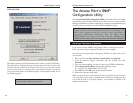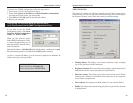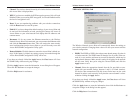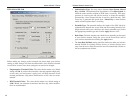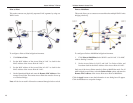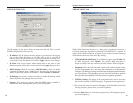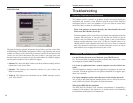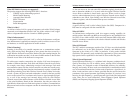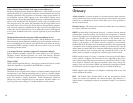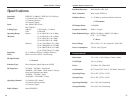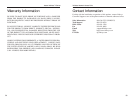
Wireless Network Access Point
As the user moves on, the end node’s RF transmitter regularly checks the sys-
tem to determine whether it is in touch with the original Wireless Network
Access Point or whether it should seek a new one. When a node no longer
receives acknowledgment from its original Wireless Network Access Point, it
undertakes a new search. Upon finding a new Wireless Network Access Point,
it then re-registers, and the communication process continues.
What is BSS ID?
A specific Ad-hoc LAN is called a Basic Service Set (BSS). Computers in a
BSS must be configured with the same BSS ID.
What is ESSID?
An Infrastructure configuration could also support roaming capability for
mobile workers. More than one BSS can be configured as an Extended Service
Set (ESS). Users within an ESS could roam freely between BSSs while main-
taining a continuous connection to the wireless network stations and Wireless
Network Access Points.
What is ISM band?
The FCC and their counterparts outside of the U.S. have set aside bandwidth
for unlicensed use in the ISM (Industrial, Scientific and Medical) band.
Spectrum in the vicinity of 2.4 GHz, in particular, is being made available
worldwide. This presents a truly revolutionary opportunity to place convenient
high speed wireless capabilities in the hands of users around the globe.
What is Spread Spectrum?
Spread Spectrum technology is a wideband radio frequency technique devel-
oped by the military for use in reliable, secure, mission-critical communica-
tions systems. It is designed to trade off bandwidth efficiency for reliability,
integrity, and security. In other words, more bandwidth is consumed than in the
case of narrowband transmission, but the trade-off produces a signal that is, in
effect, louder and thus easier to detect, provided that the receiver knows the
parameters of the spread-spectrum signal being broadcast. If a receiver is not
tuned to the right frequency, a spread-spectrum signal looks like background
noise. There are two main alternatives, Direct Sequence Spread Spectrum
(DSSS) and Frequency Hopping Spread Spectrum (FHSS).
49
Instant Wireless™ Series
What IEEE 802.11 features are supported?
The product supports the following IEEE 802.11 functions:
• CSMA/CA plus Acknowledge protocol
• Multi-Channel Roaming
• Automatic Rate Selection
• RTS/CTS feature
• Fragmentation
• Power Management
What is Ad-hoc?
An Ad-hoc wireless LAN is a group of computers, each with a WLAN adapter,
connected as an independent wireless LAN. An Ad-hoc wireless LAN is appli-
cable at a departmental scale for a branch or SOHO operation.
What is Infrastructure?
An integrated wireless and wired LAN is called an Infrastructure configura-
tion. Infrastructure is applicable to enterprise scale for wireless access to a cen-
tral database, or wireless application for mobile workers.
What is Roaming?
Roaming is the ability of a portable computer user to communicate continu-
ously while moving freely throughout an area greater than that covered by a
single Wireless Network Access Point. Before using the roaming function, the
workstation must make sure that it is the same channel number as the Wireless
Network Access Point of the dedicated coverage area.
To achieve true seamless connectivity, the wireless LAN must incorporate a
number of different functions. Each node and Wireless Network Access Point,
for example, must always acknowledge receipt of each message. Each node
must maintain contact with the wireless network even when not actually trans-
mitting data. Achieving these functions simultaneously requires a dynamic RF
networking technology that links Wireless Network Access Points and nodes.
In such a system, the user’s end node undertakes a search for the best possible
access to the system. First, it evaluates such factors as signal strength and qual-
ity, as well as the message load currently being carried by each Wireless
Network Access Point and the distance of each Wireless Network Access Point
to the wired backbone. Based on that information, the node next selects the
right Wireless Network Access Point and registers its address. Communications
between end node and host computer can then be transmitted up and down the
backbone.
48



